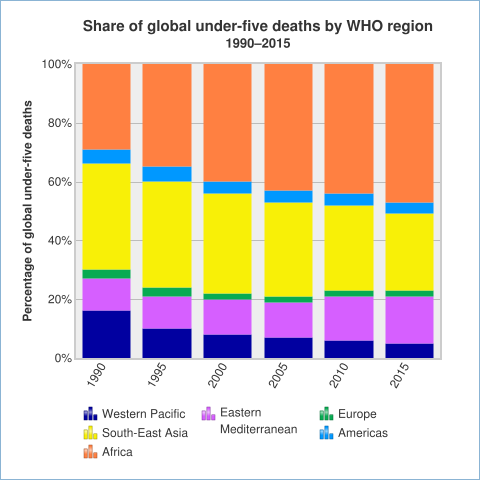
5.9 million Children under age five died in 2015, 16 000 every day.
The risk of a child dying before completing five years of age is still highest in the WHO African Region (81 per 1000 live births), about 7 times higher than that in the WHO European Region (11 per 1000 live births). Many countries still have very high under-five mortality – particularly those in WHO African Region, home to 6 of the 7 countries with an under-five mortality rate above 100 deaths per 1000 live births. In addition, inequities in child mortality between high-income and low-income countries remain large. In 2015, the under-five mortality rate in low-income countries was 76 deaths per 1000 live births – about 11 times the average rate in high-income countries (7 deaths per 1000 live births). Reducing these inequities across countries and saving more children’s lives by ending preventable child deaths are important priorities.
Trends
Globally, under-five mortality rate has decreased by 53%, from an estimated rate of 91 deaths per 1000 live births in 1990 to 43 deaths per 1000 live births in 2015. The average annual rate of reduction in under-five mortality has accelerated – from 1.8% a year over the period 1990–2000 to 3.9% for 2000–2015 – but remains insufficient to reach MDG 4. About 19 000 fewer children died every day in 2015 than in 1990, the baseline year for measuring progress.
With the end of the MDG era, the international community is in the process of agreeing on a new framework – the Sustainable Development Goals (SDGs) where the target is to end preventable deaths of newborns and children under 5 years of age. The proposal is for all countries aiming reduce under-five mortality to at least as low as 25 per 1000 live births. Currently, 79 countries have an under-five mortality rate above 25, and 47 of them will not meet the proposed SDG target of 25 deaths per 1000 live births by 2030 if they continue their current trends in reducing under-five mortality.
Source: WHO
 FR
FR EN
EN AR
AR








